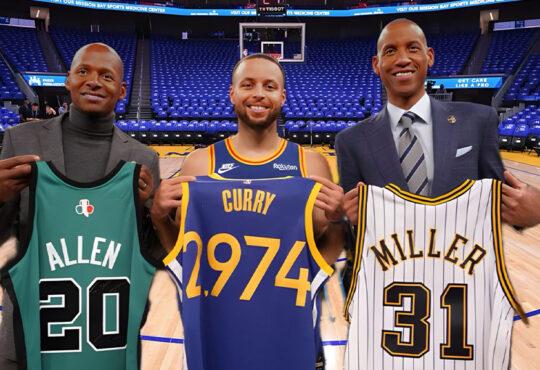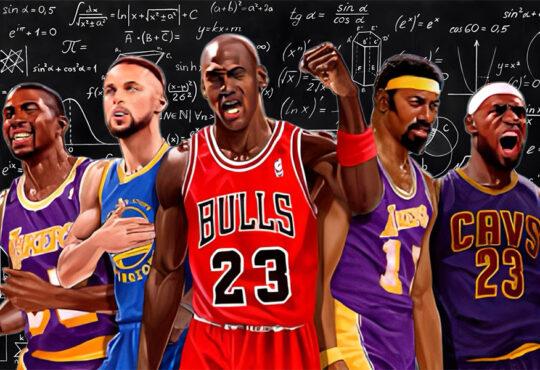
Why Does the NBA Do a Draft Lottery?
Why Does the NBA Do a Draft Lottery? The NBA Draft Lottery determines the order of selection for the NBA Draft. The 14 teams that did not make the 2022 playoffs were eligible for the Lottery.
The NBA Board of Governors approved changes to the lottery system in 2017. Under the revamped format, which began with the 2019 Draft, the NBA Draft Lottery will ensure that the team with the worst record will receive no worse than the fifth pick. Under the pre-2019 system, the team with the worst record would pick no lower than fourth.
The new system levels the odds at the top of the NBA Draft Lottery so that the teams with the three worst regular-season records will each have a 14 percent chance of winning the lottery. In the pre-2019 structure, the top seed had a 25 percent winning the lottery, the second seed had a 19.9 percent and the third seed had a 15.6 percent.
After drawings are conducted for the first four picks of the NBA Draft, the other lottery teams will continue to pick in inverse order of their regular-season record.
How specifically does the Lottery work?
The actual lottery procedure takes place in a separate room just before ESPN’s national broadcast. A media member, NBA officials, and a representative of the accounting firm Ernst & Young are in attendance for the drawings.
Fourteen ping-pong balls numbered 1 through 14 are placed in a lottery machine. There are 1,001 possible combinations when four balls are drawn out of 14, without regard to their order of selection. Before the lottery, 1,000 of those 1,001 combinations are assigned to the 14 participating lottery teams.
The lottery machine is manufactured by the Smart Play Company, a leading manufacturer of state lottery machines throughout the United States. Smart Play also weighs, measures and certifies the ping-pong balls before the drawing.
The drawing process occurs in the following manner: All 14 balls are placed in the lottery machine and they are mixed for 20 seconds, and then the first ball is removed. The remaining balls are mixed in the lottery machine for another 10 seconds, and then the second ball is drawn. There is a 10-second mix, and then the third ball is drawn. There is a 10-second mix, and then the fourth ball is drawn. The team that has been assigned that combination will receive the No. 1 pick. The same process is repeated with the same ping-pong balls and lottery machine for the second through fourth picks.
If the same team comes up more than once, the result is discarded and another four-ball combination is selected. Also, if the one unassigned combination is drawn, the result is discarded and the balls are drawn again.
The length of time the balls are mixed is monitored by a timekeeper who faces away from the machine and signals the machine operator after the appropriate amount of time has elapsed.
A partner from Ernst & Young oversees the entire lottery process and stuffs and seals the envelopes before bringing them to the studio for the broadcast. Neither the Deputy Commissioner nor the virtual team representatives are informed of the lottery results before the envelopes are opened.
The team whose logo is in the last envelope opened has the No. 1 pick in the NBA Draft.
What are the odds for each team in the Draft Lottery?
The changes implemented for 2021 will result in the following odds for teams starting with the reverse order of the regular-season record.
Team > Odds for No. 1 Pick
- Team 1 > 14.0%
- Team 2 > 14.0%
- Team 3 >14.0%
- Team 4 > 12.5%
- Team 5 > 10.5%
- Team 6 > 9.0%
- Team 7 > 7.5%
- Team 8 > 4.5%
- Team 9 > 4.5%
- Team 10 > 4.5%
- Team 11 > 1.8%
- Team 12 > 1.7%
- Team 13 > 1.0%
- Team 14 > 0.5%
What about picks 15-60?
The Draft selections for the remainder of the first round (No. 15-30) and the entire second round (No. 30-60), are determined by reverse order of regular-season record. Each NBA team gets one selection in the first round and one selection in the second round.
What is the history of the NBA Draft Lottery and when was it first used?
From 1966 through 1984, the NBA team that finished with the worst record in each conference participated in a coin flip. The team that won the coin flip received the No. 1 overall pick in the NBA Draft. That team that lost the coin flip received the No. 2 overall pick. The remaining teams are picked in inverse order of their regular-season records.
In 1984, The NBA Board of Governors voted to adopt a lottery system among the non-playoff teams (or the teams holding their picks through trades) to determine their order of selection in the first round of the NBA Draft, beginning in 1985. Teams would pick in inverse order of their regular-season records in the second round (or before the draft was reduced to two rounds in 1989, in all succeeding rounds).
In 1986, under a procedural change adopted by the Board of Governors, the lottery would determine the order of selection for the first three teams only. The remaining non-playoff teams would select in inverse order of their regular-season records. Therefore, the team with the worst record would be assured of picking no worse than fourth, the team with the second-worst record no worse than fifth, and so on.
In 1989, the NBA Board of Governors adopted a weighted system, beginning with the 1990 NBA Draft Lottery, which included 11 teams due to expansion (Charlotte and Miami joined the NBA for the 1988-89 season and Minnesota and Orlando followed in 1989-90). The team with the worst regular-season record received 11 chances at the top pick (out of a total of 66), the second-worst team got 10 chances, and the team with the best record among the non-playoff teams was given one chance.
In 1993, the NBA Board of Governors approved a modification that, effective with the 1994 NBA Draft Lottery, increased the chances of the teams with the worst records to win one of the top three picks while decreasing the chances of the teams with the best records. The new system increased the chances of the team with the worst record of drawing the first pick from 16.7 percent to 25 percent, and it decreased the chances of the team with the best record among lottery teams from 1.5 percent to 0.5 percent.
In 1995, the NBA Board of Governors increased the number of teams participating in the lottery from 11 to 13 to account for the addition of expansion teams in Toronto and Vancouver. Starting in 1996, the team with the worst record would continue to have a 25 percent chance of winning the first pick. Teams two through six would have slightly fewer chances, team seven would have the same chances, and teams eight through 12 would have slightly more chances. The number of chances for team 13 did not change.
The 2004 NBA Draft Lottery increased to 14 teams with the addition of the Charlotte Bobcats. However, as part of their expansion agreement, the Bobcats were locked into the fourth position in the 2004 NBA Draft and therefore did not have a chance to receive other picks in the lottery.
In 2017, the NBA Board of Governors approved changes to the lottery system effective with the 2019 NBA Draft, reducing the odds so that the teams with the three worst records would share the same chance (14 percent) of receiving the No. 1 overall draft pick. The odds for the remaining participants in the 14-team lottery would be reduced gradually after the top three. Drawings would be conducted for the first four picks of the NBA Draft. The other lottery teams would continue to pick in inverse order of their regular-season record.
What is the biggest surprise wins in Draft Lottery history?
After years of either directly having the team with the worst record picking No. 1 in the Draft or using a coin flip, between the worst teams from each Conference to determine who would pick No. 1 in that year’s Draft, the NBA adopted the Lottery system in 1985.
The Lottery system provided every non-playoff team with an equal chance at landing that year’s No. 1 pick. A few years in, the weighted Lottery system was introduced in 1990 to provide the team with the worst record with the best chance of landing the No. 1 pick.
Over the years, through multiple reforms to the weighted Lottery system, the odds for the team with the worst record to win the Lottery and get the chance to choose No. 1 has changed, but the objective has been to favor them in a manner that’s fair and random.
Having said that, the weighted Lottery still does give every non-playoff team a chance at the No. 1 pick. Under this new system, only 11 times have the teams with the worst (7) or second-worst (4) record won the Lottery.
The odds are highly stacked against the teams with the better records but there have been multiple years when there have been some unexpected winners, so let’s revisit some of the biggest surprise winners in NBA Draft Lottery history:
1993 – Orlando Magic
Pre-Draft odds: 1.52% (worst odds)
The Magic, having just joined the league in 1989, had won the Draft Lottery the previous year. After picking the dominant big man and future Hall of Famer Shaquille O’Neal with the No. 1 pick in 1992, the franchise posted their (then) best record and first non-losing season by going 41-41.
After being tied for the eighth and final playoff spot in the East with the Indiana Pacers, they missed out on the postseason due to a tiebreaker. Thus, they were owners of the best record among the non-playoff teams and had the least chance of landing the No. 1 pick.
Despite the odds, just three years after the weighted lottery was adopted, the Magic were the beneficiary of a huge upset as they won the 1993 Draft Lottery. In fact, their win is the biggest upset in NBA Draft Lottery history.
With the No. 1 pick, they picked Chris Webber but traded him to the Golden State Warriors, owners of the No. 3 pick, for Anfernee “Penny” Hardaway and three future first-round draft picks. The duo of O’Neal and Hardaway transformed the franchise into one of the best in the league.
Over a three-year stint (1993-96), the franchise’s best at that time and second-best ever, the Magic won a combined 167 games (67.9 percent) including the franchise’s only 60-win campaign and the first of two NBA Finals trips.
2008 – Chicago Bulls
The Bulls were coming off a 33-49 season, their first non-playoff year after three straight postseason trips. Their record was just three games off the final playoff spot in the East, so the hopes of a high draft pick shouldn’t have been high but they were. In the three previous Draft lotteries (2005, 2006, 2007), teams had overcome huge odds to land the No.1 pick.
With the No. 1 pick, the Bulls selected Chicago native Derrick Rose. The 6’2″ guard out of Memphis changed the face of the franchise and led them to their most successful non-Michael-Jordan years in franchise history.
Over Rose’s first four years, before he tore his ACL in the first round of the 2012 playoffs, the Bulls won a combined 194 games (59.1 percent). It included the team’s only Conference Finals (2011) and 60-win regular season without Jordan.
2011 – LA Clippers
Pre-Draft odds: 2.80% (8th most of 14)
Having won 32 games in the 2010-11 season, the Clippers missed the playoffs for the fifth straight year but given their record, they weren’t favored to win the Lottery as their odds indicate. Either way, their pick was to go to the Cleveland Cavaliers, who had the second-best odds that year, as part of a Baron Davis and Mo Williams trade in February of 2011.
Eventually, the Cavaliers were owners of the first pick of the No.1 pick but not because of their odds but by virtue of receiving the Clippers’ pick.
With the top selection of that year’s Draft, the Cleveland franchise picked Kyrie Irving. While it didn’t pay dividends immediately, having the All-NBA caliber talent in Irving and Tristan Thompson – their selection with the No. 4 pick in the 2011 Draft – on their roster was a huge reason why LeBron James decided to return home after four years with the Miami Heat.
That, in turn, led the team to have their most successful four-year stint from 2014 to 2018 with four consecutive NBA Finals trips which included the’s franchise’s lone NBA Championship courtesy of a historic 3-1 series comeback in the 2016 Finals against the 73-win Golden State Warriors.
2014 – Cleveland Cavaliers
Pre-Draft odds: 1.70% (9th most of 14)
Since James left in 2010, the Cavaliers bottomed out and went from a 61-win team to a 19-win team, gradually improving each year with Irving on the roster to 21 to 24 and finally to 33 wins, which didn’t favor them to land any of the top picks as they held the ninth-best odds to land No. 1.
Instead, in one of the biggest surprises in Lottery history, they won the sweepstakes for the top pick and were set to pick No. 1 for the third time in four years.
Although they selected Andrew Wiggins with the top pick in the 2014 Draft, they traded him to the Minnesota Timberwolves for Kevin Love, the final piece to the team’s Big 3 alongside James and Irving. The rest is history.







